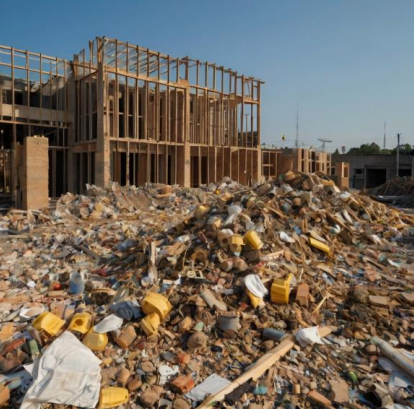
Welcome to our second lesson in the course on Waste Management and Recycling in Construction. Today, we will focus on the environmental
impact of construction waste. Understanding these impacts is vital for appreciating the importance of effective waste management practices.
Learning Objectives
By the end of this lesson, you will be able to:
Recognize the environmental consequences of construction waste.
Understand the lifecycle of construction waste and its ecological footprint.
Identify strategies to mitigate the environmental impact of construction waste.
Environmental Impact of Construction Waste
Construction waste significantly affects the environment in various ways. Let's explore these impacts in detail:
1. Landfill Overuse
Volume: Construction and demolition waste accounts for a large portion of total waste in landfills.
Space Consumption: This waste occupies significant landfill space, reducing the availability for other types of waste and contributing
to the expansion of landfill sites.
Land Degradation: Landfills can cause soil degradation, affecting local ecosystems and wildlife habitats.
2. Resource Depletion
Raw Materials: Construction waste often contains valuable materials like metals, wood, and minerals.
Energy Consumption: Extracting and processing new materials require substantial energy, contributing to resource depletion.
Biodiversity Loss: Mining and deforestation for new materials can lead to habitat destruction and loss of biodiversity.
3. Pollution
Soil Contamination: Hazardous materials in construction waste, such as asbestos, lead, and chemicals, can leach into the soil,
contaminating it and affecting plant and animal life.
Water Pollution: Runoff from construction sites and improper disposal of hazardous waste can contaminate water bodies, harming
aquatic ecosystems and human health.
Air Pollution: Burning construction waste or allowing materials to decompose improperly can release harmful pollutants into the air,
contributing to respiratory problems and environmental degradation.
4. Greenhouse Gas Emissions
Decomposition: Organic materials like wood can produce methane, a potent greenhouse gas, when decomposing in anaerobic landfill
conditions.
Energy Use: The production, transportation, and disposal of construction materials consume energy, often generated from fossil fuels,
leading to CO2 emissions.
Waste Incineration: Burning waste can release CO2 and other pollutants, contributing to global warming and air quality issues.
5. Visual and Noise Pollution
Aesthetics: Construction waste can be unsightly, affecting the visual appeal of urban and natural landscapes.
Noise: The process of handling and transporting waste can contribute to noise pollution, impacting local communities and wildlife.
Mitigating Environmental Impact
To mitigate the environmental impact of construction waste, several strategies can be employed:
1. Waste Reduction
Design Efficiency: Use design strategies that minimize waste, such as prefabrication and modular construction.
Material Efficiency: Opt for materials that have a longer lifespan and can be used more efficiently.
2. Recycling and Reuse
Material Recovery: Implement on-site recycling programs to recover and reuse materials like metals, concrete, and wood.
Repurposing: Find new uses for materials that would otherwise be discarded, reducing the need for new resources.
3. Sustainable Practices
Green Building: Follow green building standards and certifications (e.g., LEED) that emphasize waste reduction and sustainability.
Eco-friendly Materials: Use materials that are environmentally friendly, such as recycled or sustainably sourced products.
4. Proper Disposal of Hazardous Waste
Special Handling: Ensure hazardous materials are handled and disposed of according to regulations to prevent contamination.
Awareness and Training: Educate workers on the importance of proper hazardous waste management and the environmental
consequences of improper disposal.
Conclusion
Understanding the environmental impact of construction waste underscores the importance of effective waste management practices. By
recognizing these impacts and implementing strategies to reduce, recycle, and responsibly dispose of waste, we can significantly mitigate the
ecological footprint of construction activities.